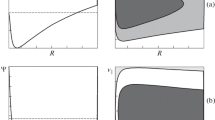Abstract
The article presents simulation results for the motion of electrons in two different regions: a high-current vacuum diode and an open trap. The entire system is immersed in an external magnetic field with sharp-point geometry. The electrons are continuously injected from a part of the cathode into the diode region, where they are accelerated to relativistic velocities. In this region, the self-consistent problem of particle motion in electromagnetic fields is solved by the “large” particle method. In the magnetic trap region, the particles experience only the external magnetic field, and their paths are computed by the test particle method. The simulation efficiency is improved by partitioning the problem into two: separate simulation of the high-voltage diode and integration of the particle paths in the trap. Calculations show that the bulk of the particles leave the trap through the side walls, moving along the magnetic forcelines, and only a small part of the particles undergo multiple reflections and remain longer inside the trap.
Similar content being viewed by others
REFERENCES
C. Badsell and A. Langdon, Plasma Physics and Simulation [Russian translation], Énergoatomizdat, Moscow (1989).
Yu. A. Berezin and M. P. Fedoruk, Simulation of Nonstationary Plasma Processes [in Russian], Nauka, Novosibirsk (1993).
J. P. Boris, “Relativistic plasma simulation-optimization of a hybrid code,” in: J. P. Boris and R. Shanny (eds.), Proc. 4 th Conf. on Numerical Simulation of Plasmas, US Government Printing Office, Washington, DC (1970), pp. 3–67.
O. Buneman, “Time reversible difference procedures,” J. Comput. Phys., 1, No. 4, 517–535 (1967).
A. Langdon and B. Lazinsky, “Electromagnetic and relativistic computer plasma models,” in: Controlled Thermonuclear Fusions [Russian translation], Mir, Moscow (1980), pp. 347–394.
D. S. Filippychev, “Computing magnetic fields in open traps,” in: Software Library for Solving Boundary-Value Problems by Difference Methods [in Russian], Izd. MGU, Moscow (1983), pp. 111–116.
L. D. Landau and E. M. Lifshits, Field Theory [in Russian], Nauka, Moscow (1973).
R. Hockney, “Potential computing methods and their applications,” in: Computational Methods in Plasma Physics [Russian translation], Mir, Moscow (1974), pp. 143–212.
A. A. Samarskii, Theory of Difference Schemes [in Russian], Nauka, Moscow (1977).
L. D. Landau and E. M. Lifshits, Electrodynamics of Continua [in Russian], Nauka, Moscow (1982).
Rights and permissions
About this article
Cite this article
Filippychev, D.S. Computing the Particle Paths in an Open-Trap Sharp-Point Geometry. Computational Mathematics and Modeling 12, 193–210 (2001). https://doi.org/10.1023/A:1012589205469
Issue Date:
DOI: https://doi.org/10.1023/A:1012589205469



